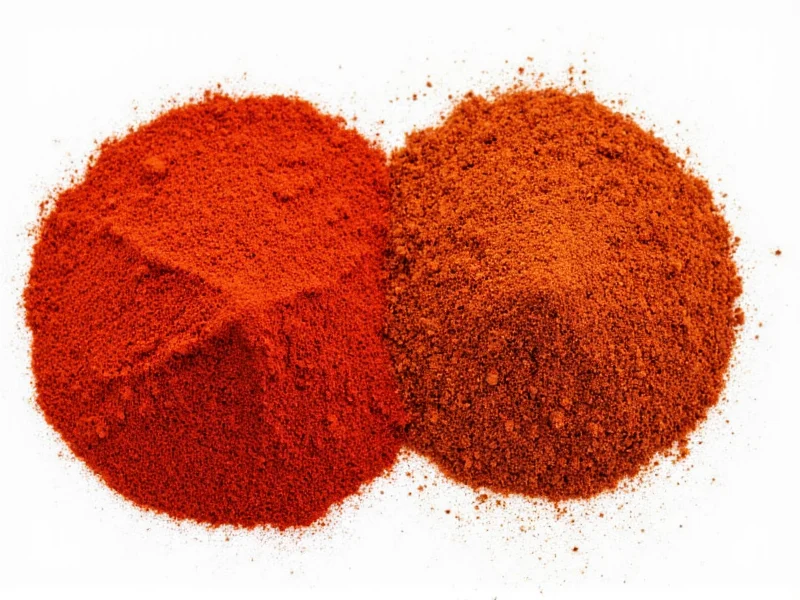Understanding the distinction between sweet paprika and regular paprika is essential for precise cooking results. Both spices originate from ground dried peppers, but their flavor profiles and culinary applications differ in important ways that can significantly impact your dishes.
What Exactly Is Paprika?
Paprika is a ground spice made from dried sweet or chili peppers belonging to the Capsicum annuum species. Originating in Central Mexico and brought to Europe by Spanish explorers, it became particularly prominent in Hungarian cuisine. The quality and flavor of paprika depends on the pepper varieties used, growing conditions, and processing methods.
Standard paprika (often labeled simply as “paprika” in stores) typically refers to a mild variety that provides rich red color and subtle pepper flavor without significant heat. However, the term “regular paprika” can be ambiguous as it might mean:
- The basic sweet variety common in American supermarkets
- A Hungarian-style paprika with more complex flavor notes
- A generic product that could vary between brands
Sweet Paprika Defined
Sweet paprika is specifically formulated to deliver consistent mildness. Made exclusively from sweet red peppers with no spicy varieties included, it contains zero Scoville heat units. This variety emphasizes the natural sweetness of the peppers with flavor notes that can include:
- Fruity undertones
- Subtle earthiness
- Mild pepper flavor without any burn
- Possible hints of bitterness in some varieties
Sweet paprika is the variety most commonly found in standard American grocery stores and is ideal for dishes where you want color and mild pepper flavor without any heat.
Comparing Sweet Paprika and Regular Paprika
| Characteristic | Sweet Paprika | Regular Paprika |
|---|---|---|
| Heat Level | 0 Scoville units (completely mild) | Mild (500-1,000 Scoville units), though some varieties may be hotter |
| Primary Ingredients | Exclusively sweet red peppers | Mixture of sweet and sometimes slightly pungent peppers |
| Flavor Profile | Clean, sweet pepper flavor with possible fruity notes | More complex with possible smoky, earthy, or slightly bitter notes |
| Color | Bright red | Deep red to brick red |
| Common Regional Varieties | American sweet paprika | Hungarian sweet, Spanish smoked, California mild |
| Best Culinary Uses | Deviled eggs, potato salad, light-colored sauces | Goulash, stews, roasted meats, spice rubs |
Regional Differences in Paprika Terminology
One reason for confusion between sweet paprika vs paprika is regional naming conventions. In Hungary, paprika comes in eight distinct varieties ranging from édesnödéli (sweet) to erős (hot). When Americans refer to “regular paprika,” they usually mean the sweet Hungarian variety.
In Spain, paprika (pimentón) is often smoked (pimentón de la Vera), which adds another dimension that doesn't exist in standard sweet paprika. Understanding these regional differences helps clarify what you're actually getting when you purchase “regular” paprika.
Culinary Applications: When to Use Which
Choosing between sweet paprika and regular paprika depends on your recipe's requirements:
Sweet Paprika Best Uses
- Recipes requiring vibrant red color without any heat
- Light-colored sauces and dressings where even mild heat would be noticeable
- Traditional deviled eggs and potato salads
- As a finishing spice for visual appeal
- Recipes specifically calling for “sweet paprika”
Regular Paprika Best Uses
- Hearty stews and goulashes needing deeper flavor complexity
- Meat rubs where subtle earthiness enhances flavor
- Recipes from specific regional cuisines (Hungarian, Spanish)
- Dishes where a hint of natural pepper bitterness complements other flavors
- Situations where you want paprika flavor without the specificity of sweet variety
Substitution Guidance
If you need to substitute one for the other:
- Sweet paprika can generally replace regular paprika when you want to ensure zero heat
- Regular paprika can substitute for sweet paprika in most recipes, but may add subtle complexity
- Never substitute hot paprika for sweet paprika unless you want to add significant heat
- For American recipes calling for “paprika,” sweet paprika is almost always appropriate
Storage and Freshness Tips
Both sweet and regular paprika lose potency over time. For best results:
- Store in airtight containers away from light and heat
- Use within 6-12 months for optimal flavor
- Check freshness by aroma—fresh paprika has a vibrant, sweet pepper scent
- Stale paprika appears duller in color and has little aroma
Common Misconceptions Clarified
Several myths persist about sweet paprika versus regular paprika:
- Misconception: “Sweet paprika contains added sugar” Reality: The “sweet” refers to the pepper variety, not added sugar
- Misconception: “Regular paprika is always hotter than sweet paprika” Reality: In many markets, “regular” and “sweet” are synonymous
- Misconception: “Hungarian paprika is always hot” Reality: Hungarian paprika comes in sweet, semi-sweet, and hot varieties











 浙公网安备
33010002000092号
浙公网安备
33010002000092号 浙B2-20120091-4
浙B2-20120091-4